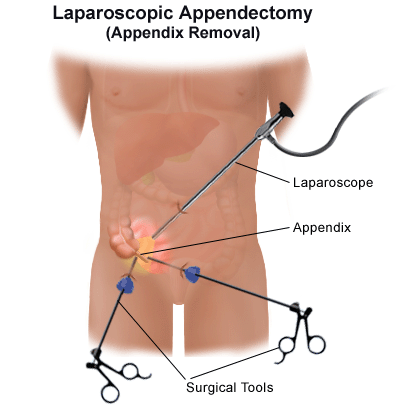Dr. Ahmad has performed more than 4,000 robotic surgeries, including robotic gastric bypass, robotic sleeve gastrectomy, robotic hernia procedures, robotic anti-reflux procedures, robotic colon operations and robotic gallbladder surgery. He is recognized in Long Island as one of the most advanced robotic surgeons in the country. Dr. Ahmad founded and is the director of the Robotic and Bariatric Surgery Center of Excellence at Mather Northwell Hospital. This is the only intuitive certified epicenter in Long Island for robotic bariatric surgery as of June 2020.

Appendectomy is the surgical removal of appendix, a small finger-shaped organ attached to the cecum (first part of the colon). Appendectomy is indicated in appendicitis, the inflammation of appendix and can be done two ways.
The older method, laparotomy, removes the appendix through a single-incision in the lower right area of the abdomen. The newer methods, laparoscopic and robotic surgery, uses several smaller incisions and special surgical tools fed through the incisions to remove the appendix.
During laparoscopic and robotic appendectomy, the surgeon makes an incision over the abdomen and inserts a harmless gas into the abdominal cavity to expand the viewing area of the abdomen. Surgeon inserts a trocar into an incision through which the laparoscope is introduced into the abdomen. Additional small incisions may be used for inserting surgical instruments to be used during the procedure.
With the images from the laparoscope as a guide, the surgeon can look at the appendix and determine the extent of the problem and remove the appendix. Once the appendix is removed, the area is washed with sterile fluid to minimize the risk of infection. The tiny incisions are closed and covered with small bandages. Laparoscopic and robotic surgery leads to fewer complications, such as hospital-related infections, and has a shorter recovery time.
Make an Appointment
Other General Surgery Procedures
- Laparoscopic/Robotic Hernia Repair
- Laparoscopic/Robotic Cholecystectomy
- Laparoscopic/Robotic Fundoplication for Acid Reflux
- Robotic LINX Procedure for Acid Reflux
- Laparoscopic/Robotic Splenectomy
- Transoral Incisionless Fundoplication (TIF)
- Laparoscopic/Robotic Colon Resection
- Laparoscopic/Robotic Colon Resection for Diverticulitis
- Laparoscopic/Robotic Heller Myotomy for Achalasia
- Laparoscopic/Robotic Adrenalectomy
- Laparoscopic Surgery
- Laparoscopic Appendectomy
- Upper Endoscopy
- Gastrointestinal Conditions








